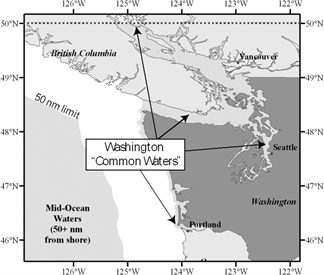PDFWAC 220-650-070
Interim open sea exchange requirements.
(1) Purpose. Until otherwise required to meet performance standards under WAC 220-650-090 and prior to discharging ballast water into Washington waters, vessel owners or operators must exchange their ballast water to meet or exceed state interim open sea exchange requirements or use an approved exchange alternative. An open sea exchange is intended to reduce the number of higher risk coastal organisms in a ballast tank by replacing them with open sea organisms that are less likely to invade waters of the state, and by changing the salinity and other ambient water conditions to further reduce populations of remaining coastal species. Vessel owners or operators who do not discharge ballast water into waters of the state are exempt from this section but must continue to meet the reporting and other requirements under WAC 220-650-030.
(2) Open sea exchange methodology.
(a) In general. An open sea exchange must result in an efficiency of at least ninety-five percent volumetric exchange of the total ballast water capacity for each tank. An open sea exchange requires using either an empty/refill method or a flow through method.
(b) Empty/refill exchange. Preferred - This type of exchange requires, for each ballast tank that contains ballast water to be discharged into waters of the state, at least one empty/refill cycle in an open sea exchange area designated by the department under subsection (3) of this section. Vessel owners or operators should remove as close to one hundred percent, but not less than ninety-five percent, of the ballast water as is safe to do so. If this is not possible, then perform a flow through exchange under (c) of this subsection.
(c) Flow through exchange. This type of exchange requires, for each ballast tank that contains ballast water to be discharged into waters of the state, pumping or otherwise forcing a minimum of three times the total ballast tank capacity's volume in an open sea exchange area designated by the department under subsection (3) of this section. For example, a ballast tank with a one thousand cubic meter capacity, regardless of actual ballast water in the tank, would require pumping three thousand cubic meters of open sea water through the tank. In all flow through exchange operations, open sea water must be pumped into the bottom and discharged out the top of the tank. Where department evaluation determines more flow through volume is required to meet the ninety-five percent exchange requirements, a compliance plan or alternative strategy may be required under WAC 220-650-060.
(3) Open sea exchange areas.
(a) In general. Ballast water exchanges must be conducted in open sea (also called midocean or mid-ocean) areas based upon originating port as defined herein. In all exchange situations, the vessel owner or operator must file a ballast water reporting form per WAC 220-650-030(2).
(b) Voyages from outside the United States Exclusive Economic Zone (EEZ). A vessel owner or operator en route to a state of Washington port or place, from a port or place outside the United States EEZ, shall conduct an open sea exchange:
(i) Before entering waters of the state;
(ii) At least two hundred nautical miles from any shore; and
(iii) In waters greater than two thousand meters deep.
(c) Coastal voyages. A vessel owner or operator who does not voyage two hundred nautical miles or greater from any shore shall conduct ballast water exchange:
(i) Before entering waters of the state;
(ii) At least fifty nautical miles from any shore; and
(iii) In water at least two hundred meters deep.
(4) Common water exemption. Vessels voyaging from a port within the common water zone to a port in Washington state are exempt from having to conduct a ballast water exchange if the ballast water and sediment originated solely from a valid exchange prior to entering the common waters or from uptake within an area that includes only the waters of Washington state, the Oregon portions of the Columbia River system, and the internal waters of British Columbia south of latitude fifty degrees north, including the waters of the Straits of Georgia and Juan de Fuca (Figure 1). The common waters area relates only to vessels voyaging to a Washington state port or place from another Washington state port or place, or from designated Canadian and Oregon waters to waters of the state. It does not imply or provide any regulatory authority for vessels voyaging from waters of the state to Oregon and Canadian waters, or voyages to or between Canada and Oregon. Please refer to Canadian and Oregon ballast water laws for their requirements.
 |
(5) Safety exemptions. Nothing in this chapter relieves the vessel owner or operator from ensuring the safety and stability of the vessel, its crew, or its passengers. A vessel owner or operator is not required to conduct an open sea exchange, in part or in full, if the vessel owner or operator determines that the operation would threaten the safety of the vessel, its crew, or its passengers. In these situations, the vessel operator must file a ballast water reporting form and is subject to all other provisions under WAC 220-650-030(4).
(6) Alternative discharge areas. The department, in consultation with states of concurrent waters, may identify alternative discharge areas as promulgated by department policy.
(7) Prohibited discharge areas. A vessel may not discharge ballast water or sediment within a marine protected or conservation area as designated under chapter 220-16 WAC.
[Statutory Authority: RCW 77.04.020, 77.12.045, 77.12.047, 77.120.040(5). WSR 18-08-013, § 220-650-070, filed 3/22/18, effective 4/22/18. Statutory Authority: RCW 77.04.012, 77.04.013, 77.04.020, 77.04.055, and 77.12.047. WSR 17-05-112 (Order 17-04), recodified as § 220-650-070, filed 2/15/17, effective 3/18/17. Statutory Authority: RCW 77.12.047, 77.120.030, 77.120.040, and 77.120.070. WSR 09-14-052 (Order 09-110), § 220-150-040, filed 6/25/09, effective 7/26/09.]